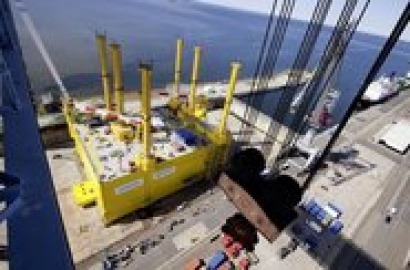
TenneT has accepted the project following the successful completion of test runs by Siemens and the connection is now in commercial operation. The offshore platform of the BorWin2 grid connection is located around 100 kilometers off the German coast, northwest of the island of Borkum. The grid connection will enable the transmission of 800 MW of clean electricity from wind power, enough energy to supply around one million German households.
“This is the first offshore grid connection worldwide to take up commercial operation with efficient direct-current technology” said Jan Mrosik, CEO of the Siemens Energy Management Division.
Lex Hartman, member of the managing board of TenneT TSO GmbH added that the BorWin2 link is a major contribution to Germany’s energy transition. The platform is 51 meters wide, 72 meters long, 25 meteres high and weighs around 16,000 metric tons. Siemens installed the platform in the North Sea at a depth of 39 meters in April 2014 and linked it to the Global Tech 1 wind farm which has 80 turbines. Fifty percent of the platform’s grid connection capacity is available for the connection of a second wind farm.
In summer 2010 TenneT contracted a consortium consisting of Siemens and Prysmian, the latter company being an Italian cable specialist. Siemens is now implementing five North Sea grid connection projects for TenneT, which consist of the HelWin1(576 MW) and HelWin2 (690 MW) off of Helgoland, BorWin2 (800 MW) and BorWin3 (900 MW) off of Borkum and SylWin1 (864 MW) off of Sylt.
Three more grid connections, Sylwin1, HelWin1 and HelWin2, are nearly complete. They are scheduled to take up commercial operation in the first half of 2015. BorWin3, the latest order for a grid connection in the North Sea received by Siemens, was received by the company in the spring of 2014 and commissioning of a fifth grid connection is scheduled for 2019. These grid connections will have a total transmission capacity of more than 3.8 GW and will provide electricity from offshore wind power to supply around five million households.
Siemens high-voltage direct current (HVDC) technology will keep transmission losses for each grid connection, including cable losses, below 4 percent. The HVDC has been installed on the offshore platforms and in the land-based converter stations. The wind-based electricity is transmitted as alternating current to the converter platform, transformed into direct current and fed to the mainland via a subsea cable. The land-based station converts the direct current back into alternating current and feeds the electricity into the extra-high voltage grid. HVDC is the only efficient transmission solution for cable lengths of more than 80 kilometres.
The HVDC Plus technology used by Siemens is less complex and extremely compact, making it predestined for use in sea-based applications. In contrast to classic HVDC technology used in a vast majority of land links, systems equipped with HVDC Plus feature self-stabilization. As fluctuations in the grid must always be reckoned with for wind-based power generation, grid stability and reliability is enhanced considerably through the use of the HVDC Plus technology.
For additional information:

